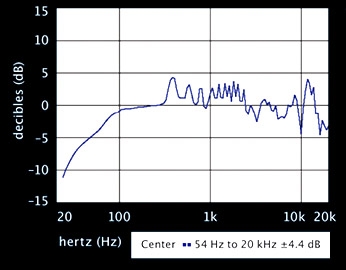Definitive Technology Mythos SSA-50 soundbar speaker Page 3

 |
TEST BENCH
The only channel in the SSA-50 that doesn't employ filtering and crosstalk cancellation is the center channel, so that's the one we measured. When the speaker is on a stand, the response is reasonably smooth, with a few severe peaks and dips above 8 kHz. Place the speaker against a wall, and a big dip centered at 560 Hz appears. Off-axis performance of the center channel is excellent. The impedance drops low in all channels, and sensitivity isn't high, so don't try to drive the SSA-50 with some $200 A/V receiver.
IN THE LAB
Frequency response (at 2 meters) Center channel (stand-mounted) 54 Hz to 20 kHz ±4.4 dB Center channel (wall-mounted) 54 Hz to 20 kHz ±5.0 dB Sensitivity (SPL at 1 meter with 2.8 volts of pink-noise input) center channel 88 dB left/right channels 89 dB surround channels 84 dB Impedance (minimum/nominal) center channel 3.9/5 left/right channels 3.7/5.5 surround channels 4.0/5.5 The frequency-response curve in the graph is weighted to reflect how sound arrives at a listener's ears with normal speaker placement. All measurements were made at 2 meters. The SSA-50 was measured first on a 6-foot stand, which gives quasi-anechoic results to about 200 Hz including full effects of cabinet diffraction and front panel reflections. Then we measured it with its back flat atop a sheet of drywall on the ground to simulate the acoustic effects of wall-mounting. In both cases, response of the woofer was close-miked and spliced to the quasi-anechoic response.
These measurements apply only to the center channel. Because of the HRTF filtering and crosstalk cancellation used in the left, right, left surround, and right surround channels, there's no point in measuring them - you have to have a brain in the chain to interpret the sonic cues.
Frequency response of the center speaker is not bad for a concentric configuration with the tweeter hovering above the woofer. The response on a stand is a bit smoother, with a mild recess in the midrange and lower treble (from 2.5 kHz to 10.5 kHz) and a pronounced peak at 11.7 kHz. The curve looks similar for the quasi-wall-mount measurement, although broad peaks appear centered at about 340 Hz and 1.1 kHz, with a big dip centered at 560 Hz. Thus, the SSA-50 sounds good against a wall, but should sound even better if you place it on a TV stand. Thanks to the concentric driver arrangement, off-axis performance is outstanding, with nary a difference below 10 kHz at 30° off-axis. In fact, at 20° and 30° off-axis, the performance above 10 kHz is actually better, because that 11.7 kHz peak disappears.
Are you dying to know how the other channels measure? OK, I'll spill the beans: The left and right channels run ±9.4 dB, the left and right surrounds ±19.5 dB. That's mostly due to the effect of the cross-cancellation. In your brain, you don't hear all that unevenness. Sadly, microphones don't have brains.
The impedance of the various speakers incorporated in the SSA-50 runs surprisingly low, given that this product will almost certainly be used with a relatively inexpensive receiver. However, the impedance phase response is forgiving, rarely exceeding plus or minus 30 degrees. But the sensitivity is just average in the front channels and quite low in the surround channels, so the SSA-50 definitely demands a decent receiver to power it.
- Log in or register to post comments












































